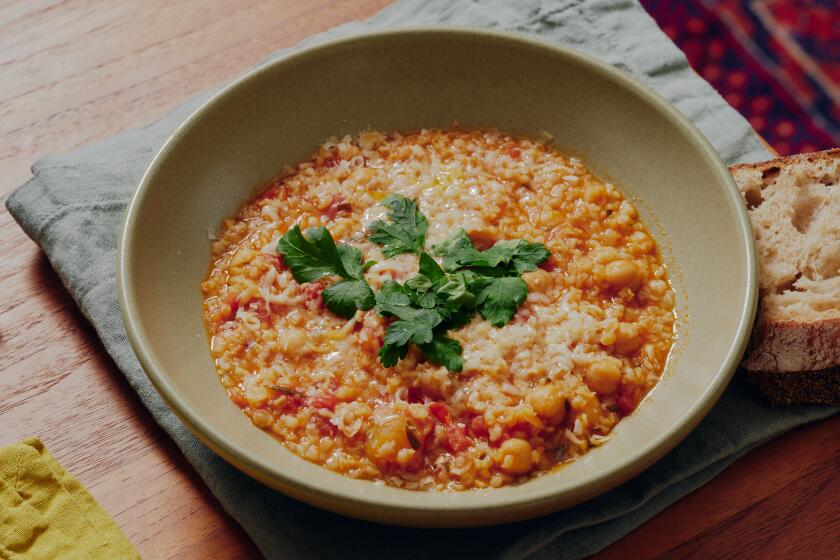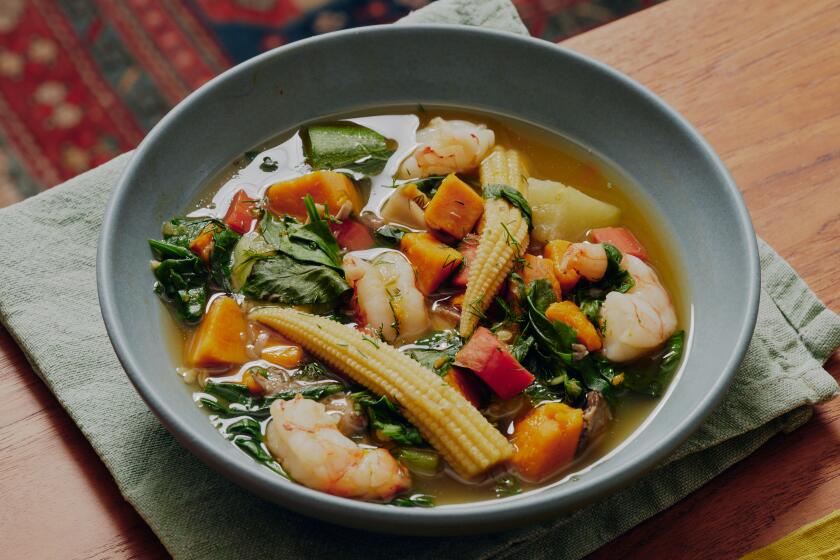Vibul Wonprasat's Khao Tom

Breakfast cereal in the United States means something crunchy scooped out of a box from the supermarket, a bowl of granola or perhaps oatmeal, cooked in haste in the microwave.
In Asia itâs a different story. Breakfast cereal could be rice soup in Thailand, wheat porridge studded with nuts, curry leaves and chiles in India, a semolina cake soft with bananas in Myanmar, a ball of rice stuffed with coconut and brown sugar in Sri Lanka or a powdery mixture of roasted barley and dried fruits in Nepal.
Interesting traditions surround these foods. Thai khao tom--rice soup embellished with meat, hot chiles and other toppings--is eaten at either end of the day, says Vibul Wonprasat of Venice, artistic director of the annual Thai Cultural Day in Los Angeles. âThais believe liquid is easier to digest in the morning, before working,â he explains. âLunch is a heavier meal. When working late at night, Thais like to have liquid food before going to bed.â
Wonprasat, an artist, takes special pains in preparing khao tom. He cooks the rice in bottled water to simulate the rainwater that Thais collect in huge urns for kitchen use. Broken jasmine rice, available in some Asian markets, softens and breaks down into a creamy puree ideal for porridge. The label may say âbroken riceâ or specify jasmine broken rice and may also include the Vietnamese name for the broken grains, cao thom.
Garlic-flavored pork meatballs garnish Wonprasatâs soup, along with cilantro and a dash of black pepper. Side dishes of fish sauce and sliced chiles soaked in vinegar provide additional seasoning.
In south India, one might breakfast on upma, a wheat porridge that includes vegetables, chiles, black mustard seeds and curry leaves. Vasanti Jayaswal of West Los Angeles makes upma in the style of Bangalore, although she is from Trivandrum in the state of Kerala. To give a nutty flavor, she includes a small amount of lightly browned Indian dal, or roasted cashews can also be added.
Leilei Thein of San Diego calls her Burmese banana cake banana shwe gye. In Burmese, âshwe gyeâ means semolina, which she uses instead of regular flour. Made with coconut milk as well as evaporated milk, the sweet cake is as likely to show up at breakfast as at other times of day. âIn Myanmar, no distinction is made between what is served for breakfast or for afternoon tea,â explains Thein, who grew up in Mawlamyine (formerly Moulmein) in southern Myanmar. âWe eat a lot of snack food at breakfast time too.â
Bhante Walpola Piyananda, abbot of the Dharma Vijaya Buddhist Vihara in Los Angeles, tells a legend about the origin of Sri Lankan kiribath (milk rice), which is rice cooked with coconut milk and salt. âThis is sacred food to Sri Lankans, as well as delicious,â he says. âIt is the last food that the Buddha ate before being enlightened. A servant girl saw him meditating and perceived him as god. She ran to her mistress, who then prepared kiribath for the holy person and brought it to the Buddha. He was enlightened one day later.â
For auspicious days, kiribath rice would be served for breakfast, spread flat on a platter and accompanied by jaggery (brown sugar), treacle and bananas.
In a variation, the rice is molded in small cups and then filled with coconut in jaggery syrup. This recipe, called coppa kiribath, appears in the âCeylon Daily News Cookery Book,â which has been continuously reprinted since it was first published in Colombo in 1929.
Barley sattu could be called Nepali granola, the way Narayan Somname prepares it. Somname, a Nepali chef working in Japan, sent the recipe to a friend, Bijay Niraula, who is president of the Himalayan Arts and Cultural Council of the Pacific Asia Museum in Pasadena. Somname mixes powdered hulled barley grains with raisins, cashews, coconut, sugar candy, cinnamon and cardamom.
âSattu can be eaten with both cold or hot milk,â Niraula says. âIt can also be mixed with plain yogurt.â Powdery rather than crunchy, sattu is handy food for travelers and campers. The labor involved in pounding the grains to a powder, as is done in Nepal, would discourage most cereal lovers from trying this dish. However, the recipe works well with barley flour from a natural foods store.
Adding raisins, nuts, coconut and spices also breaks with Nepali tradition. There, sattu is frugal food, eaten plain or mixed with water. But Somnameâs fancy version is a lot more palatable and just might find a place on an American breakfast table.
Combine the rice vinegar with the sliced chiles and let stand so the chiles become pickled.
Meanwhile, place the pork on a cutting board. Top with the garlic and the fish sauce. With a Chinese cleaver or other sharp, heavy knife, chop the meat and garlic together until finely minced, almost pasty.
Place the rice in a large saucepan, add 3 cups of water and cook over low heat until creamy, about 30 to 35 minutes. The rice will soften and break down, like a puree. Keep adding water as needed so that it stays fluid like a soup. Stir in 1 teaspoon of salt. Keep warm over low heat.
Shape the pork mixture into small patties 2 to 3 inches wide. Heat the oil in a skillet over medium heat. Fry the patties in batches until browned and cooked through, 2 to 3 minutes a side.
Ladle the rice soup into 4 large soup bowls. Place 3 or 4 pork patties in each bowl. Garnish with cilantro and pepper to taste.
Serve with fish sauce and vinegar-chile mixture, letting diners season their own soup.
Get our Cooking newsletter.
Your roundup of inspiring recipes and kitchen tricks.
You may occasionally receive promotional content from the Los Angeles Times.















